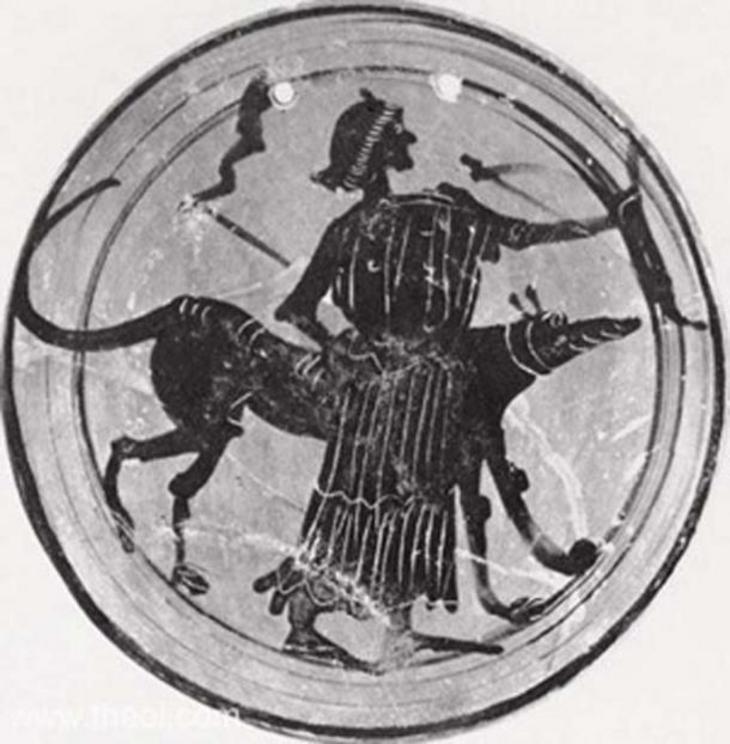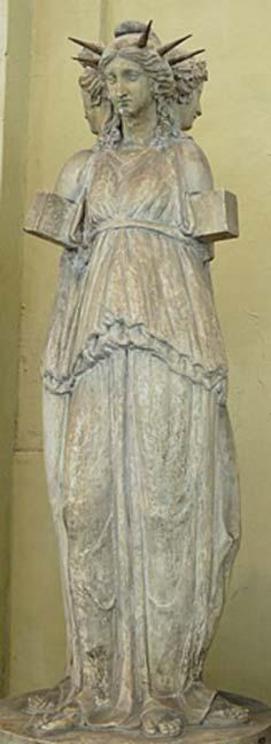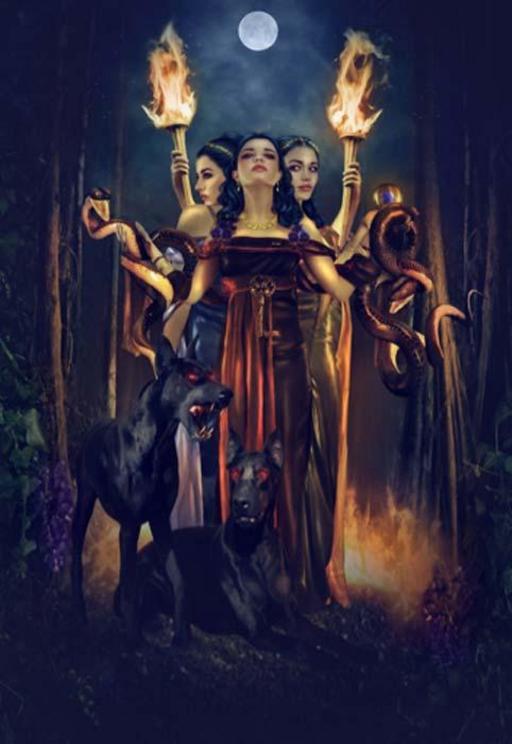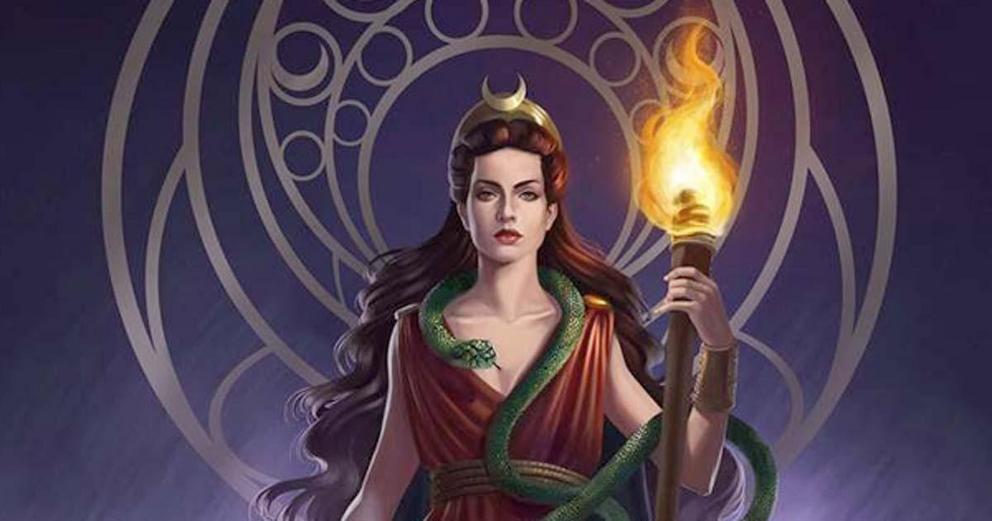Hecate: holding court over ancient greek witchcraft, the moon, and ghosts
"I am she that is the natural mother of all things, mistress and governess of all the elements, the initial progeny of worlds, chief of powers divine, Queen of heaven, the principal of the Gods celestial, the light of the goddesses: at my will the planets of the air, the wholesome winds of the Seas, and the silences of hell be disposed; my name, my divinity is adored throughout all the world in divers manners, in variable customs and in many names, [...] Some call me Juno, others Bellona of the Battles, and still others Hecate. Principally the Ethiopians which dwell in the Orient, and the Egyptians which are excellent in all kind of ancient doctrine, and by their proper ceremonies accustomed to worship me, do call me Queen Isis."
- Lucius Apuleius, The Golden Ass
According to Greek mythology, Hecate was a goddess primarily associated with magic and witchcraft. Her sphere of influence also included the moon, night, crossroads, ghosts, and necromancy . Although she was considered to be a powerful goddess, Hecate was not a major deity when compared, for instance, to the Twelve Olympians. Thus, there are not many myths that revolve around her. Nevertheless, Hecate plays an important role in the myth known as the ‘Abduction of Persephone’. It is also from this myth that the quintessential representation of Hecate, i.e. as a goddess holding a flaming torch in each hand, is derived.
Hecate’s Powers
It is generally believed that Hecate was the daughter of Perses and Asteria, both of whom were Titans of the second generation. Others, however, have claimed that she was the daughter of Zeus and either Hera or Pheraea. Yet others have stated that she was a daughter either of Leto or of Tartarus. In any case, Hecate is reckoned to have not originally been part of her Greek pantheon, and her cult is said to have originated in ancient Thrace, or perhaps in Caria, Anatolia. The original worshippers of Hecate believed that the goddess had power over heaven, earth, and the seas, thus making her an incredibly powerful goddess.

Hekateion (little votive column to Hecate). The triple-body goddess is surrounded by three dancing Charites. Attica, ca. 3rd century BC. ( Public Domain )
Hecate had the power not only to bestow upon those she favored wealth, good fortune, and wisdom, but also to withhold these gifts from those she perceived as unworthy. She was honored by all the gods, including Zeus. As she sided with the Olympians during the Titanomachy, she was the only member of the old regime who retained her powers following the defeat of the Titans.
Due to her extensive powers, Hecate has been confused and identified with several other deities. For instance, as a goddess of nature, she was identified with Demeter, whilst as a Moon goddess, she has been identified with Persephone.

A goddess, probably Hekate or else Artemis, is depicted with a bow, dog and twin torches. ( Public Domain )
Hecate in Myth
Unfortunately, there are not many myths about Hecate. Nevertheless, the goddess is mentioned in the myth of Persephone’s abduction by Hades . In fact, she plays an important role in this tale. Hecate is mentioned in Homer’s version of the myth, which is known as the Homeric Hymn to Demeter.
According to the poet, Hecate was the only deity, apart from the sun god Helios, who witnessed the abduction of Persephone. Therefore, when Demeter, the goddess of agriculture and Persephone’s mother, began the search for her daughter, Hecate, with a flaming torch in each hand, accompanied her. After Persephone was found, Hecate became her companion and attendant. During the time of the Greek tragedians, the notion that Hecate was a chthonic deity due her association with Persephone became common.

Terracotta bell-krater (bowl for mixing wine and water) depicting (from left to right) Persephone, Hermes, Hekate and Demeter. ( The Metropolitan Museum of Art )
The Goddess Hecate in Art
It was due to this myth that the typical image of Hecate in artwork was formed. Initially, she was represented as a single-formed goddess in a long robe. In each of her hands, the goddess held a flaming torch, a clear reference to the role she played in the myth of Persephone’s abduction. Later on, however, she was represented as a triple-formed goddess.

Triple-formed representation of Hecate. Marble, Roman copy after an original of the Hellenistic period. ( Public Domain )
In this representation, Hecate has three bodies that stand back-to-back, and it has been speculated that this was meant to allow the goddess to look in all three directions simultaneously. This concurs with her role as a deity in charge of crossroads. It is also due to this role that pillars called Hecataea were erected at crossroads. Such pillars stood also at doorways, and likely served an apotropaic function.
Hecate’s power was eventually reduced and her sphere of influence became more specified. As a result, she is best remembered as a mystical goddess who is associated with magic and sorcery. This transformation of Hecate has been traced to 5th century Athens.

A modern representation of a triple-formed Hecate. (mari-na/ Deviant Art )
In the works of the 4th century tragedians Sophocles and Euripides, for instance, Hecate was depicted as a goddess of witchcraft, whilst just a century earlier, she was depicted as a much more powerful and amplified goddess, as seen in the works of Aeschylus. Her role is further reinforced by the fact that she is the goddess who is mentioned most frequently in magical texts, for instance, the Greek Magical Papyri, as well as on curse tablets .

Detail of a modern representation of Hecate. Source: Amino Wiki
For full references please use source link below.
